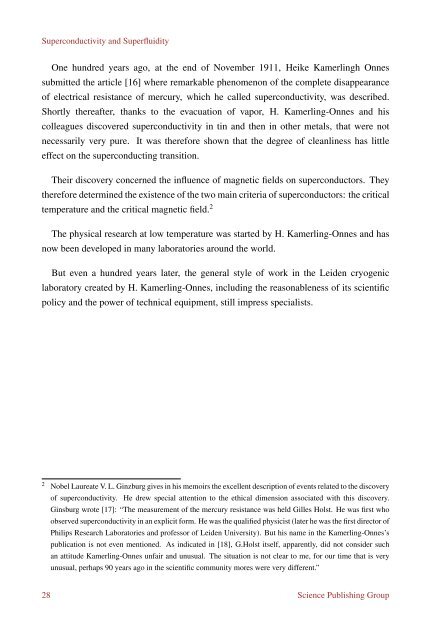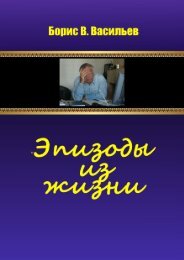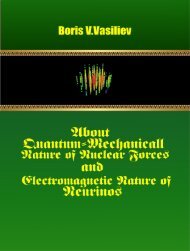978-1-940366-36-4_WholeBook
Boris V. Vasiliev Supercondustivity Superfluidity
Boris V. Vasiliev
Supercondustivity Superfluidity
You also want an ePaper? Increase the reach of your titles
YUMPU automatically turns print PDFs into web optimized ePapers that Google loves.
Superconductivity and Superfluidity<br />
One hundred years ago, at the end of November 1911, Heike Kamerlingh Onnes<br />
submitted the article [16] where remarkable phenomenon of the complete disappearance<br />
of electrical resistance of mercury, which he called superconductivity, was described.<br />
Shortly thereafter, thanks to the evacuation of vapor, H. Kamerling-Onnes and his<br />
colleagues discovered superconductivity in tin and then in other metals, that were not<br />
necessarily very pure. It was therefore shown that the degree of cleanliness has little<br />
effect on the superconducting transition.<br />
Their discovery concerned the influence of magnetic fields on superconductors. They<br />
therefore determined the existence of the two main criteria of superconductors: the critical<br />
temperature and the critical magnetic field. 2<br />
The physical research at low temperature was started by H. Kamerling-Onnes and has<br />
now been developed in many laboratories around the world.<br />
But even a hundred years later, the general style of work in the Leiden cryogenic<br />
laboratory created by H. Kamerling-Onnes, including the reasonableness of its scientific<br />
policy and the power of technical equipment, still impress specialists.<br />
2 Nobel Laureate V. L. Ginzburg gives in his memoirs the excellent description of events related to the discovery<br />
of superconductivity. He drew special attention to the ethical dimension associated with this discovery.<br />
Ginsburg wrote [17]: “The measurement of the mercury resistance was held Gilles Holst. He was first who<br />
observed superconductivity in an explicit form. He was the qualified physicist (later he was the first director of<br />
Philips Research Laboratories and professor of Leiden University). But his name in the Kamerling-Onnes’s<br />
publication is not even mentioned. As indicated in [18], G.Holst itself, apparently, did not consider such<br />
an attitude Kamerling-Onnes unfair and unusual. The situation is not clear to me, for our time that is very<br />
unusual, perhaps 90 years ago in the scientific community mores were very different.”<br />
28 Science Publishing Group













